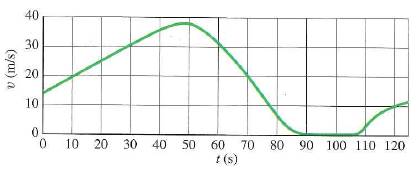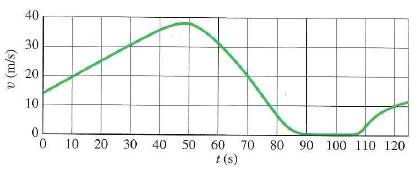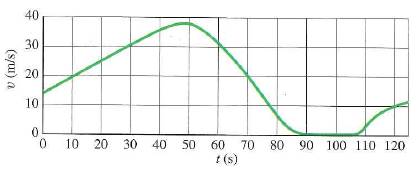
Concept explainers
(a)
The time when velocity is greatest.
(a)
Answer to Problem 49P
Velocity is at peak at
Explanation of Solution
Given:
The velocity-time graph is shown below.

Calculation:
For the given velocity-time graph, it is observed that peak value of velocity is
Conclusion:
Therefore, velocity is at peak at
(b)
To find: The time period, for the constant velocity.
(b)
Answer to Problem 49P
Velocity is constant for
Explanation of Solution
Given:
The velocity-time graph is shown below.

Calculation:
From the given graph, it is observed that the curve is a flat line or shows a constant value from time range approximately from 90 seconds to 108 seconds. It means between this time interval train is moving in a straight line with the same speed irrespective of time.
Conclusion:
Therefore, velocity is constant during
(c)
To find: The time period, for the constant acceleration.
(c)
Answer to Problem 49P
Acceleration is constant from,
Explanation of Solution
Given:
The velocity-time graph is shown below.

Formula used:
Acceleration is calculated as
Calculation:
As shown in the graph, constant acceleration is obtained by deducing the slope of the velocity-time graph. Here, acceleration is constant in two different intervals, firstly in the starting period of
Conclusion:
Therefore, acceleration is constant in
(d)
To find: The time for the greatest acceleration.
(d)
Answer to Problem 49P
The magnitude of the acceleration is at a peak at
Explanation of Solution
Given:
The velocity-time graph is shown below.

Calculation:
As shown in the graph, The magnitude of the acceleration is greatest when the slope is at a peak i.e. at
Conclusion: The magnitude of the acceleration is at a peak at
Chapter 2 Solutions
Physics: Principles with Applications
Additional Science Textbook Solutions
University Physics Volume 2
Life in the Universe (4th Edition)
The Cosmic Perspective Fundamentals (2nd Edition)
College Physics: A Strategic Approach (3rd Edition)
Sears And Zemansky's University Physics With Modern Physics
Conceptual Integrated Science
 College PhysicsPhysicsISBN:9781305952300Author:Raymond A. Serway, Chris VuillePublisher:Cengage Learning
College PhysicsPhysicsISBN:9781305952300Author:Raymond A. Serway, Chris VuillePublisher:Cengage Learning University Physics (14th Edition)PhysicsISBN:9780133969290Author:Hugh D. Young, Roger A. FreedmanPublisher:PEARSON
University Physics (14th Edition)PhysicsISBN:9780133969290Author:Hugh D. Young, Roger A. FreedmanPublisher:PEARSON Introduction To Quantum MechanicsPhysicsISBN:9781107189638Author:Griffiths, David J., Schroeter, Darrell F.Publisher:Cambridge University Press
Introduction To Quantum MechanicsPhysicsISBN:9781107189638Author:Griffiths, David J., Schroeter, Darrell F.Publisher:Cambridge University Press Physics for Scientists and EngineersPhysicsISBN:9781337553278Author:Raymond A. Serway, John W. JewettPublisher:Cengage Learning
Physics for Scientists and EngineersPhysicsISBN:9781337553278Author:Raymond A. Serway, John W. JewettPublisher:Cengage Learning Lecture- Tutorials for Introductory AstronomyPhysicsISBN:9780321820464Author:Edward E. Prather, Tim P. Slater, Jeff P. Adams, Gina BrissendenPublisher:Addison-Wesley
Lecture- Tutorials for Introductory AstronomyPhysicsISBN:9780321820464Author:Edward E. Prather, Tim P. Slater, Jeff P. Adams, Gina BrissendenPublisher:Addison-Wesley College Physics: A Strategic Approach (4th Editio...PhysicsISBN:9780134609034Author:Randall D. Knight (Professor Emeritus), Brian Jones, Stuart FieldPublisher:PEARSON
College Physics: A Strategic Approach (4th Editio...PhysicsISBN:9780134609034Author:Randall D. Knight (Professor Emeritus), Brian Jones, Stuart FieldPublisher:PEARSON





